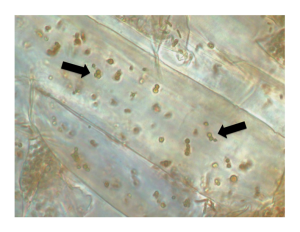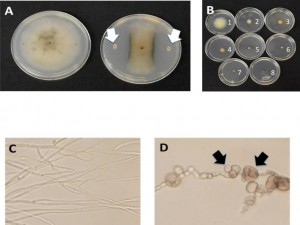James F. White, Dept. of Plant Biology and Pathology, Rutgers University, New Brunswick, NJ, USA.
Mónica S. Torres, Dept. of Plant Biology and Pathology, Rutgers University, New Brunswick, NJ, USA.
Marcos Antônio Soares, Dept. of Botany and Ecology, Universidade Federal de Mato Grosso, Cuiabá, Brazil.
Kurt P. Kowalski, U.S. Geological Survey, Great Lakes Science Center, Ann Arbor, MI, USA
April, 2015
We are investigating the question of whether symbiotic microbes (bacteria and fungi) associated with invasive Phragmites australis may play a role in increasing its invasive nature.

Figure 1. Root cells of seedlings of Phragmites containing endophytic bacteria (arrows). Bacteria colonize cells in the space between the cell wall and the plasma membrane as well as the surfaces of roots. Within root cells bacteria lose their rod shape, forming wall-less L-forms that proliferate in short chains.
Plants of all kinds are colonized by microbes on the surfaces of, and within leaves, roots, stems, fruits and seeds. Until recently, it was assumed that the microbes that were not harmful were of no consequence to plants. However, it has becoming increasingly clear that non-pathogenic fungi and bacteria are far from inconsequential and may affect host plants through mechanisms that are not presently well understood (see the recent paper in Frontiers in Microbiology by clicking here).
Our work centers on bacteria that potentially enhance the aggressiveness of Phragmites. Several endophytic bacteria (bacteria that reside inside a plant; see Figure 1) that we have found to be associated with Phragmites have a reputation for promoting both growth and defensive mechanisms in plants.
Among those growth-promotional bacteria are several Bacillus species that appear to be particularly common as endophytes in Phragmites. Many of these produce lipopeptides that inhibit fungal growth (see Figure 2). This attribute of Bacillus is so important that several strains of Bacillus are even included in commercial biological control formulations sold to control fungal diseases in horticultural crops. Lipopeptides have also been shown to trigger host defense mechanisms. Because endophytic bacterial species may reduce the incidence and severity of diseases in Phragmites, removing them could have the opposite effect.
One of the notable features of invasive Phragmites is its capacity to grow rapidly in dense stands, outcompeting and excluding other plant species. Although reduced vulnerability to pathogens as described above could contribute to the aggressive nature of Phragmites, it is plausible to believe that such extreme biomass development is also the result of growth promotion via endophytes.
Some research suggests that growth promotion could be enabled by bacteria that allow invasive Phragmites to acquire organic nitrogen better than its competitors. A recent study found that enhanced invasiveness of Phragmites was associated with an increased capacity to absorb organic nitrogen from soils. We have recently shown that bacteria may enhance organic nitrogen up-take by degrading proteins into a form that may be easily absorbed by Phragmites roots. Bacteria that colonize Phragmites roots could also activate root-produced enzymes that serve a similar function.

Figure 2. Plates showing inhibition of fungi by lipopeptides. A. Fungus growing without inhibition; inhibition of mycelial growth of fungus by Bacillus colonies (arrows). B. Fungus growing in a medium containing increasing concentrations of lipopeptides (B1 = lowest concentration; B8 = highest concentration). Inhibition increases proportionally to lipopeptide concentration in the medium. C. Fungal structures not exposed to lipopeptides. D. Swollen and contorted fungal structures (arrows) resulting from exposure to lipopeptides.
We obtained consistent data showing that Phragmites increases the length of shoots in soils that are deficient in nitrogen when seedlings are inoculated with endophytic bacteria. This enhanced nitrogen scavenging ability could also account for the faster growth and denser stands of invasive Phragmites compared to its less capable competitors. We are currently conducting experiments to evaluate how frequently invasive Phragmites exhibit enhanced organic nitrogen scavenging. We are also examining endophyte effects on plant resistance to salinity. Initial results suggest that the presence of certain endophytic bacteria enhances the capacity of plants to grow in soils with high salt concentrations.
Our goals are to develop an understanding of the nature of the symbioses of Phragmites and explore ways to target symbiotic relationships to reduce the invasiveness of the host in a non-lethal and environmentally friendly manner.
